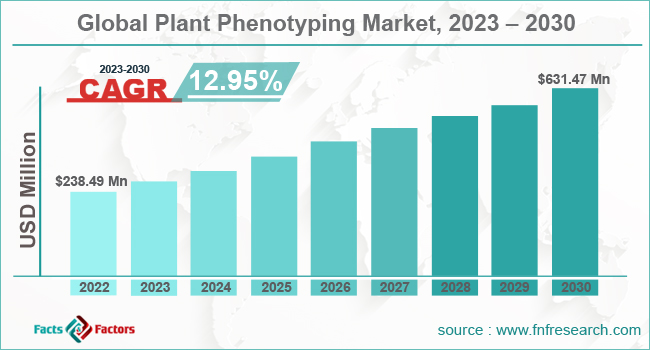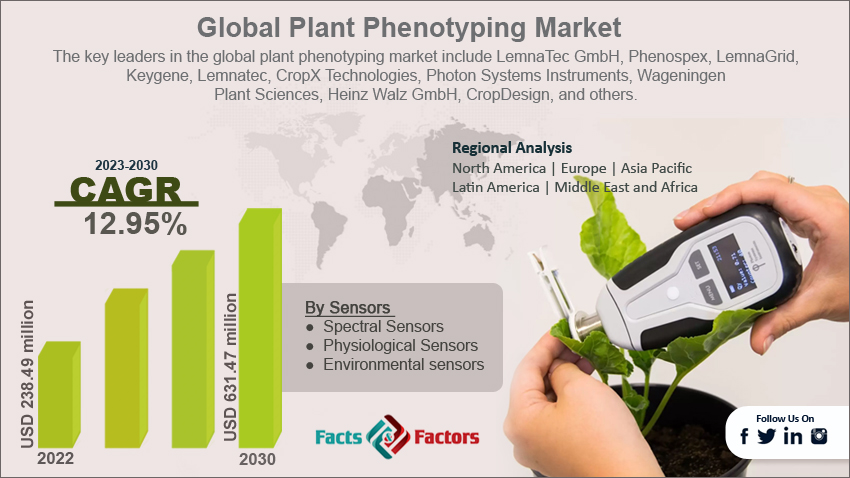Search Market Research Report
Plant Phenotyping Market Size, Share Global Analysis Report, 2023 – 2030

Plant Phenotyping Market Size, Share, Growth Analysis Report By Sensors (Spectral Sensors, Physiological Sensors, And Environmental sensors), By Software (Statistical Analysis & Modeling Software, Data Management & Integration Software, And Imaging Analysis Software), By Equipment (Phenomobiles, Robotics & Automation, Imaging Systems, And Growth Chambers), and By Region - Global and Regional Industry Insights, Overview, Comprehensive Analysis, Trends, Statistical Research, Market Intelligence, Historical Data and Forecast 2023 – 2030
Industry Insights
[220+ Pages Report] According to the report published by Facts & Factors, the global plant phenotyping market size was valued at USD 238.49 million in 2022 and is anticipated to grow to USD 631.47 million by the end of 2030. The market is anticipated to grow with a CAGR of 12.95% during the forecast period.

The plant phenotyping market report is an in-depth study on newborn eye imaging systems in the healthcare industry, focusing on growth drivers and upcoming market trends. Also, the plant phenotyping industry report offers comprehensive insights into the geographical and competitive marketplace.
 Market Overview
Market Overview
Plant phenotyping refers to the science of analyzing and measuring the different characteristics of plants, particularly in a non-destructive and high throughput manner. The process involves the quantitative assessment of plant features from different dimensions ranging from the entire plant to the individual molecules and cells.
The major aim of plant phenotyping is to know how environmental and genetic factors impact plant performance, growth, and development. The phenotypic trait is measured through physiological parameters, biochemical properties, and plant morphology.
Data analysis, sensors, and advanced imaging techniques are the widely adopted phenotyping techniques to interpret and capture the traits precisely. Plant phenotype is essential in agriculture research, crop improvement, and plant breeding. Scientists are able to recognize the most desired characteristics by studying and quantifying the plant traits which further contribute to disease resistance, stress tolerance, crop yield, and other essential agronomic traits.
 Key Insights
Key Insights
- As per the analysis shared by our research analyst, the global plant phenotyping market size is estimated to grow annually at a CAGR of around 12.95% over the forecast period (2023-2030).
- In terms of revenue, the global plant phenotyping market size was valued at around USD 238.49 million in 2022 and is projected to reach USD 631.47 million by 2030.
- The high demand for improved crop variety and focus on precision agriculture is likely to drive the growth of the global plant phenotyping market.
- Based on the sensors, the spectral sensors segment holds the largest share of the global market due to its added benefits over the other options.
- Based on the software, the data management and integration software segment accounts for the largest share of the global market.
- Based on the equipment, the imaging system segment is expected to dominate the global market.
- Based on region, North America is expected to dominate the market during the forecast period.

 Growth Drivers
Growth Drivers
- High demand for improved crop variety and focus on precision agriculture is likely to drive the growth of the global market.
There is a high requirement to develop disease-resistant, stress-tolerant, and high-yielding crop varieties to ensure food security. Phenotyping helps breeders to precisely assess and choose plants with the desired traits to boost the development of particular crop varieties. Therefore it is expected to propel the growth of the global plant phenotyping market during the forecast period. People are looking forward to precision agriculture to optimize crop production with the help of data-driven techniques to manage various resources like pesticides, fertilizers, and water.
Plant phenotype helps with important data necessary for precision agriculture practices. The high demand for precision agriculture is likely to foster developments in the global market. For instance, OptiSens, in 2023, revealed its new product named OptiSens Canopy Sensor 2.0 to establish a new algorithm that can precisely measure various parameters.
 Restraints
Restraints
- Lack of interoperability and standardization is poised to hamper the growth of the global market.
There are no standard methodologies or protocols for plant phenotyping which is expected to be a huge restraining factor in the global plant phenotyping industry during the forecast period. Harmonizing the reporting methods that are collection and analysis is essential to check compatibility and reproducibility in the market.
Also, a large volume of data extracted from sensor reading, imaging techniques, and other sources is required to be stored safely. However, it requires a robust computation infrastructure and data analysis techniques which are likely to hamper the growth of the global market significantly.
 Opportunities
Opportunities
- Integration of AI and big data analytics to offer lucrative market growth opportunities.
The integration of artificial intelligence and big data analytics is expected to revolutionize the market with data analysis and processing. The latest technologies are expected to offer valuable insights from the bulk volumes of phenotype data, which will help in decision-making in crop management and plant breeding. Developments of imaging technologies like 3D imaging, hyperspectral imaging, etc., have significantly improved the capability of plant phenotype. The advancements help improve the speed of data acquisition, efficiency, and accuracy. Therefore, such a landscape is likely to offer lucrative growth opportunities in the global plant phenotyping market during the predicted period.
 Challenges
Challenges
- Integration of multi-scale data is a big challenge in the global market.
Phenotypic traits are analyzed from the whole plant to its molecular level. However, integrating such data from different modalities and scales like genomics, sensor data, and imaging presents a big challenge in the global plant phenotyping industry. Therefore, establishing integrated analytical approaches to incorporate such data is a challenge, which in turn is expected to slow down the growth of the market during the forecast period.
 Segmentation Analysis
Segmentation Analysis
The global plant phenotyping market can be segmented into sensors, software, equipment, and region.
On the basis of sensors, the market can be segmented into spectral sensors, physiological sensors, and environmental sensors. The spectral sensors segment holds the largest share of the global market due to its added benefits over the other options. However, the environment sensor segment is expected to see a steady growth rate during the forecast period due to the fast technological developments in the segment.
On the basis of software, the market can be segmented into statistical analysis & modeling software, data management & integration software, and imaging analysis software. The data management and integration software segment accounts for the largest share of the global plant phenotyping market owing to the growing commercial activities all across the globe.
Additionally, the growing need for genomic data, sensor data, imaging data, and several other kinds of metadata for plant phenotyping is likely to further propel the growth of the segment during the forecast period. The data management software offers tools and functionality to organize heterogeneous data types into a unified database. Plant phenotyping generally generates huge amounts of data that require secure tool solutions. Therefore, the data management software helps in the proper retrieval and storage of phenotypic data.
On the basis of equipment, the market can be segmented into phenomobiles, robotics & automation, imaging systems, and growth chambers. The imaging system segment is expected to dominate the global market during the forecast period due to the fast advancements in imaging technology like fluorescence, thermal, multispectral, and hyperspectral imaging techniques. These technologies help extract detailed information about the plant characteristics like canopy structures, disease symptoms, water stress, and content parameters.
 Report Scope
Report Scope
Report Attribute |
Details |
Market Size in 2022 |
USD 238.49 Million |
Projected Market Size in 2030 |
USD 631.47 Million |
CAGR Growth Rate |
12.95% CAGR |
Base Year |
2022 |
Forecast Years |
2023-2030 |
Key Market Players |
LemnaTec GmbH, Phenospex, LemnaGrid, Keygene, Lemnatec, CropX Technologies, Photon Systems Instruments, Wageningen Plant Sciences, Heinz Walz GmbH, CropDesign, and others. |
Key Segment |
By Sensors, Software, Equipment, and Region |
Major Regions Covered |
North America, Europe, Asia Pacific, Latin America, and the Middle East &, Africa |
Purchase Options |
Request customized purchase options to meet your research needs. Explore purchase options |
 Regional Analysis
Regional Analysis
- North America holds the largest share of the global market.
North America accounts for the largest share of the global plant phenotyping market due to the rising number of initiatives taken by big companies and governments to launch advanced technology for enhancing the quality and productivity of serial gains and overcoming environmental challenges.
The major aim of the regional government is to improve the quantitative analysis of plant traits for better crop conditions. Growing investments to foster high research and development activities in the region is further likely to promote growth in the market in the forthcoming years. The government is looking forward to the number of strategies that offer nutritional content and hold the ability to overcome diseases and environmental stress, which in turn is likely to force development in the regional market.
Asia Pacific is another leading region in the plant phenotyping industry owing to the growing funding programs, grants, and incentive offerings to promote research and development in the agriculture sector to address the growing challenges of food security.
Europe is also expected to see a steady growth rate in the forthcoming years due to the growing emphasis of the regional government on funding to increase phenotyping experiments in the region. Furthermore, the existence of strong market players is expected to support the growth of the regional market.
 Competitive Analysis
Competitive Analysis
- LemnaTec GmbH
- Phenospex
- LemnaGrid
- Keygene
- Lemnatec
- CropX Technologies
- Photon Systems Instruments
- Wageningen Plant Sciences
- Heinz Walz GmbH
- CropDesign
- Others
The global plant phenotyping market is segmented as follows:
 By Sensors Segment Analysis
By Sensors Segment Analysis
- Spectral Sensors
- Physiological Sensors
- Environmental sensors
 By Software Segment Analysis
By Software Segment Analysis
- Statistical Analysis & Modeling Software
- Data Management & Integration Software
- Imaging Analysis Software
 By Equipment Segment Analysis
By Equipment Segment Analysis
- Phenomobiles
- Robotics & Automation
- Imaging Systems
- Growth Chambers
 By Regional Segment Analysis
By Regional Segment Analysis
- North America
- The U.S.
- Canada
- Mexico
- Europe
- France
- The UK
- Spain
- Germany
- Italy
- Rest of Europe
- Asia Pacific
- China
- Japan
- India
- Australia
- Southeast Asia
- Rest of Asia Pacific
- The Middle East & Africa
- Saudi Arabia
- UAE
- Egypt
- Kuwait
- South Africa
- Rest of the Middle East & Africa
- Latin America
- Brazil
- Argentina
- Rest of Latin America
Industry Major Market Players
- LemnaTec GmbH
- Phenospex
- LemnaGrid
- Keygene
- Lemnatec
- CropX Technologies
- Photon Systems Instruments
- Wageningen Plant Sciences
- Heinz Walz GmbH
- CropDesign
- Others
Frequently Asked Questions

Copyright © 2024 - 2025, All Rights Reserved, Facts and Factors


